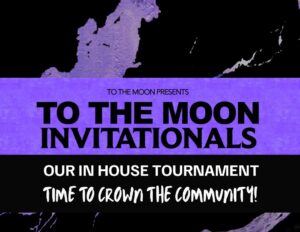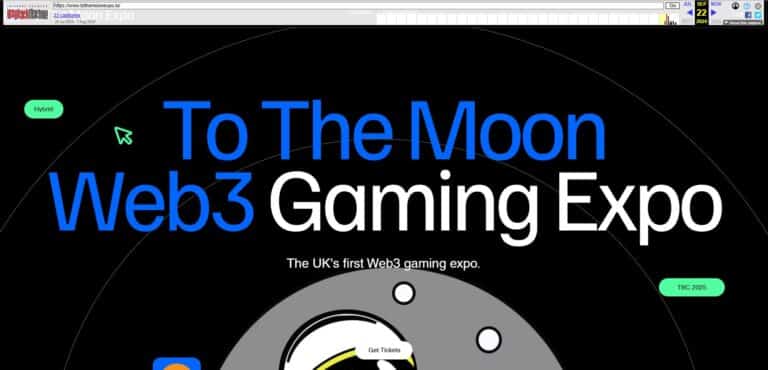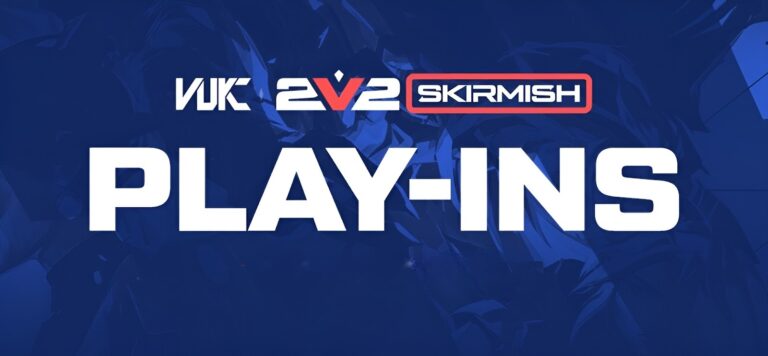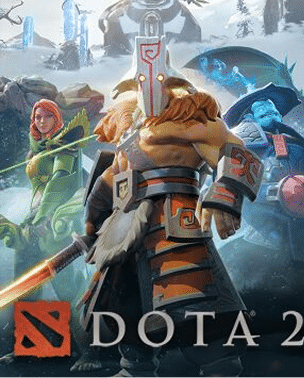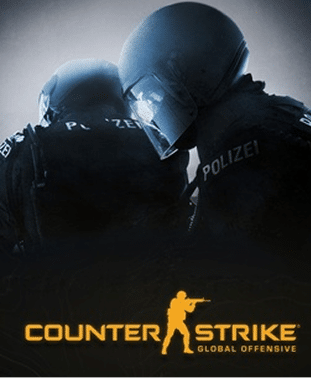Trust, respect, repairs: A deep dive into where To the Moon Expo faltered, and where there is hope for recovery
Hannah Marie ZT, Senior Editor
Last Updated: 24/11/2025
Since the To the Moon Expo debuted on November 12th, attendees, invited creators, and the wider UK games community have worked to understand why they felt the event failed to meet expectations.
ENUK has since investigated these questions, examining the history of the expo’s planning, identifying muddled promotional claims, and sourcing information directly from game exhibitors.
To the Moon Expo footfall, tech issues, and a lack of assistance
ENUK spoke with some indie game developers who showcased at the To the Moon Expo. All three were particularly intent on discussing organisational and communication issues that they experienced around the event.
One developer noted that some indie games gained more from the expo than others, primarily down to luck. With lower footfall than expected, the pool of attendees was smaller. As a result, some indie titles drew more attention than others.
Play Indie games all the way from Australia at To The Moon Expo next week! 🥳🙌
— To The Moon: Games Expo 🎮 (@ToTheMoonExpo) November 8, 2025
We are working with The Games Exchange to bring you brand new games to play from across the seas!
📅12th – 13th November
📍NEC, Birmingham pic.twitter.com/yxk9X8oK0Y
They explained to ENUK: “We were exhibiting our game there, and we’re incredibly lucky with interest in it. For many, this was unfortunately not the case, and the guy next to us left after day 1 along with other exhibitors.”
The early departure of some exhibitors was verified by a conversation with another indie game developer who was forced to close their booth early.
Disappointing footfall, faulty hired technology, and delays led them to feel it was no longer worth their investment to continue exhibiting. These issues were exacerbated by their inability to get assistance from event staff or organisers.
Due to this alleged absence of support, one exhibitor disclosed that they were forced to use their own hotspot. Their WiFi issues went unaddressed, so they could not use the network.
Network, WiFi, and connection issues also disrupted the To The Moon League of Legends £50k tournament, as per ENUK’s sources.
It is vital also to note that attendees widely expressed that the indie game developers who showcased at the To the Moon Expo were a positive contribution to the event.
ENUK’s Day 1 coverage, where To the Moon Expo was first referred to as “Dashcon but without the ballpit,” and Day 2 coverage, where dissatisfied attendees continued to communicate their views online, both highlight this enthusiasm for the indie games in attendance.
My heart goes out to everyone who attended to the moon expo this week if it underperformed. As someone who has organised a ton of events (including a stinker) I know how hard it can be to get it right. I just hope all the indie devs got lots of eyes on their games
— XPN Network (@XPNnetwork) November 14, 2025
Addressing the To the Moon Expo’s weather-based delays and setup
Some of the indie game exhibitors ENUK spoke to also expressed dissatisfaction at the delayed opening of the To the Moon expo on Day 1.
One of the game exhibitors expressed: “It was appalling how much people were lied to, and I do not believe trains were the reason they delayed opening. In fact, there were still forklifts at 11 am, an hour after it was supposed to open.”
This sentiment was echoed by two other indie developers, who told ENUK it “felt like a PR spin” or that they were generally dissatisfied with the communication regarding the issue.
When indie developers were setting up their booths, there was also allegedly a lack of guidance or instruction from the organisers.
One indie game exhibitor noted: “Upon entering, there were no tables and chairs set up for us, which everyone in the indie section paid for, so we had to set up and build ourselves with no idea where the organisers were.”
🚨 IMPORTANT! 🚨
— To The Moon: Games Expo 🎮 (@ToTheMoonExpo) November 12, 2025
We have had some issues with heavy rain causing delays and travel over night and this morning. We will be slightly delayed in opening today 11am latest.
Thank you for your patience, can't wait to welcome you all in soon! 💖 pic.twitter.com/ToE81QUBnN
Pre-event exhibitor costs caught in misfired communications
Organisers of the To the Moon Expo insisted they would provide indie game developers with a more affordable way to bring their games into the public eye.
However, the £120 exhibitor booth cost did not cover everything necessary to showcase the games to their best advantage.
One indie developer disclosed that, on top of the £120 booth cost, a message was sent to those showcasing stating that they needed to pay for their own public liability insurance for the event.
This particular developer was never approached about the insurance after this initial message, either before or during the expo. However, they had already paid the additional cost.
Furthermore, similar demands were allegedly made regarding PAT testing on electronics for game showcasing. This was rapidly reversed.
A same-day follow-up email corrected the message that PAT testing would be done on the day, and that exhibitors no longer needed to organise it themselves.
However, this particular developer stated that they were also never approached again regarding this issue before or during the event.
Notably, equipment rental and booth graphics were handled directly between NEC and exhibitors. Therefore, they were allegedly charged more costs for items like computer monitors, with graphics costing between £160 and £165 if developers wanted a more professional-looking booth.
2x DAYS TO GO! 🥳
— To The Moon: Games Expo 🎮 (@ToTheMoonExpo) November 10, 2025
Join us at the NEC, with Ready or Not, Dovetail Games, 2XKO, God Save Birmingham our indie city and SO MUCH MORE!
YES, we have actual games 😉
Ticket pricing will be higher on the door (due to extra staffing need to facilitate). Grab your ticket today 👇 pic.twitter.com/aReJMcw5F3
Extension of conditional sympathy to the To the Moon Expo organisers
One of the indie developers who reached out to ENUK was also sympathetic toward the event organisers.
They expressed the belief that the organisers had the right intentions but had fallen short of their intended outcome, and that they would need to acknowledge these shortcomings before trust could be regained.
Overall, the developer’s summary was: “They shot for the moon but landed in a puddle 6 feet in front of them.”
Importantly, this developer also expressed that if To the Moon’s organisers owned up to their missteps and laid out a plan to improve in the future, they would not be opposed to returning.
Little post-event communication has been provided. Therefore, it is unclear whether organisers will aim to learn from any misjudged actions and extend an olive branch to those who were dissatisfied.
Where due diligence became clouded by cross-organisation involvement
Since the discussion regarding the To the Moon expo began online, so has the debate over due diligence before agreeing to participate in an expo or event.
To the Moon Expo – the importance of due diligence from an experienced indie dev.
— Katie Goode (@Katie_TriPixels) November 14, 2025
There was a lot of Red Flags! So of course we decided no from the very first email they sent. Make sure we learn as an #indiedev community. Hope this helps#ToThemoon #TTM https://t.co/88CWiw4tFo
While speaking with indie game developers, ENUK learned of two outreach methods used by the To the Moon Expo organisers to contact potential exhibitors.
The first method was cold-contact emailing. However, the second method raises questions about whether organisers were using the status of a partnered organisation to convey greater trust and reliability.
Game Dev Local (GDL) is a well-respected cross-media community that supports the UK games industry.
In September 2025, two months before the To the Moon Expo, the primary event organiser became a Director at GDL. This coincided with the departure of To the Moon’s second original organiser, who was removed from the expo’s Companies House registration that same month.
His onboarding as Director was announced in a GDL Discord channel on October 2nd.
A game exhibitor who spoke to ENUK disclosed the following: “For many, we were invited by Stuart De Ville who had previously organised GDLX and had now joined to create To The Moon, and so many trusted them.”
Stuart De Ville is the CEO of GDL and was noted for being helpful to game developers during the expo, even when the official organisers were absent.
To the Moon’s primary marketing and PR contact also allegedly posted on the GDLX25 Discord channel to promote To the Moon Expo to indie developers.
Although it is not uncommon for crossover between event organisers to occur, particularly after GDL was brought on as a partner, it was likely a contributing factor for some of the indie games trusting To the Moon’s organisers.
To the Moon also announced its partnership with Indie Games Developer/Magazine three months before the event, another authoritative voice in the game development space. Although the announcement post is still live on LinkedIn, there does not appear to be any expo coverage carried out by the publication.

Where did To the Moon’s messaging go awry? Explaining the confusion among exhibitors, competitors, and the community
A core reason why many attendees and creators, along with some exhibitors, felt disappointed with To the Moon Expo was its pre-event promotional material.
Posts, graphics, and website information available online before the To the Moon expo launch frequently changed between promising “up to 15,000+ engaged attendees” and outright promising “15,000+ attendees.”
One video from official To the Moon Expo channels (posted on October 18th) confidently claimed, “we’re going to have 15,000 nerds down here.”
Repeated use of “15,000,” whether as a promise or an attendee cap, firmly conveyed that the event would be extremely well-attended.
Inconsistencies also emerged in the promotion of exhibitors, panels, and indie games. One LinkedIn post (six months pre-event) claimed there would be “150+ games, 150+ exhibitors, and 50+ industry pioneers.”
This implies over 300 activities and exhibitors.
However, another post made one month later adjusted these numbers. Instead of listing exhibitors and games separately, the promotional post mentioned only “150+ games showcased” and “50+ industry speakers.”
Even a mere two weeks before the event, one of the To the Moon Expo organisers announced: “We hit our promise of 150 games/exhibitors to play.”
This changes the language used to refer to different expo elements and adjusts the expected numbers.
Therefore, it is difficult to know how many exhibitors, booths, and activities were actually being promised.
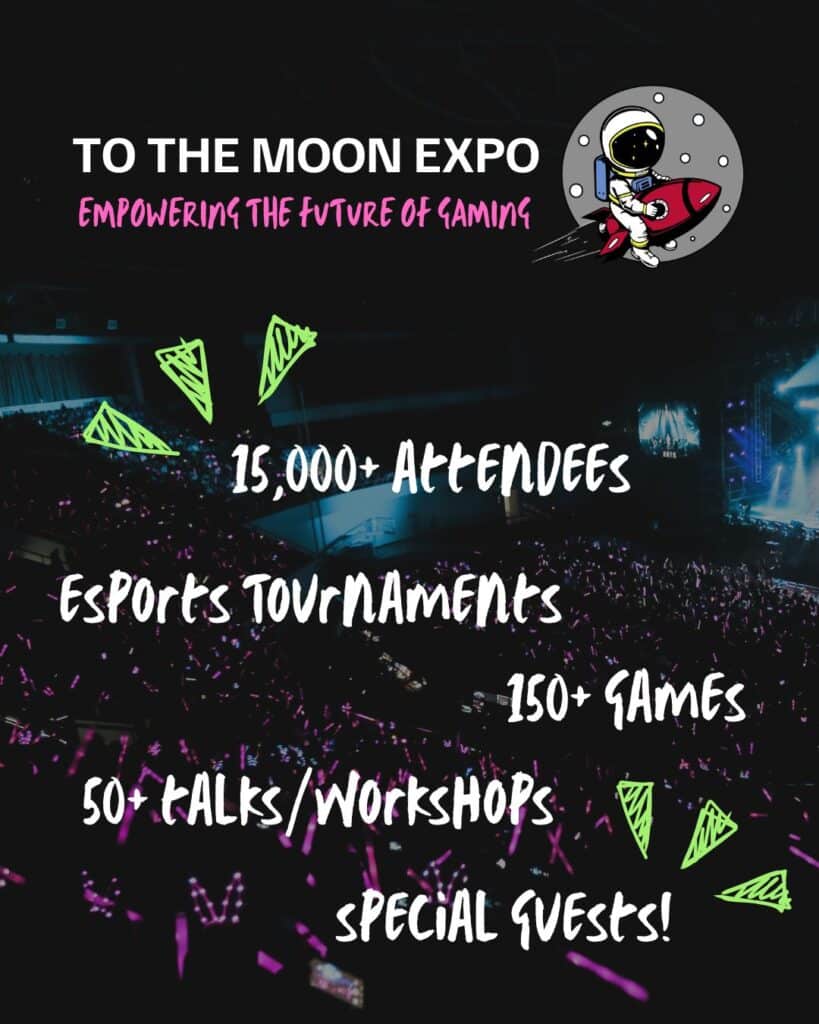
During the months leading up to the To the Moon Expo, several other events were also advertised.
One was named “GameJam,” which appeared to be plans for a Dragons’ Den-style pitch for university teams. At one point, a “Trader Hub” was advertised on the event’s website. The website also previously included advertising for a “Student Hackathon.”
Overall, conflicting communication likely contributed to the confusion and disappointment felt in To the Moon’s aftermath.
Investigating the To the Moon Expo origins – from Web3 to gaming community focus
Confused numbers and expectation adjustments extend beyond attendee and exhibitor numbers. In fact, when tracing back through the To the Moon Expo website archives, there was a significant shift in the expo’s core identity at the end of 2024.
In September 2024, the website “tothemoonexpo.io” advertised a Web3 gaming expo. The original Expo logo, displayed on the home page, was accompanied by cryptocurrency symbols.
Between September 2024 and November 2024, explicit mentions of “Web3 games” were removed from the website. However, the cryptocurrency symbols would remain on the live website until sometime between December 2024 and May 2025.

In December 2024, a Web3, blockchain, cryptocurrency, and AI company named “BlackTechDay” was also listed as an exhibitor.
From these website archives, it is clear that at conception, To the Moon Expo intended to cater to the Web3 and cryptocurrency communities. For those initiated in cryptocurrency and stock market terminology, “To the Moon” is also a common phrase used in these communities.
From ENUK’s investigation into the website’s history, it can be determined that the expo’s pivot from Web3 and cryptocurrency occurred gradually between November 2024 and May 2025.
It was from May onwards that the website reflected the UK video game community focus that was advertised heavily thereafter.
As reported in ENUK’s initial insight into what happened behind the scenes at the To the Moon Expo, advisory boards were created to support community outreach following this directional change.
However, the Esports Advisory Board was seemingly dismissed before the expo took place.
I will not be speaking at To The Moon Expo next week
— Jeff Simpkins (@HereLiesJeff) November 6, 2025
I was asked to be part of an Esports advisory group for the event some months ago; however, after the announcement, we were never consulted
The panel that I was put on last minute, had little to no structure & a loose topic
This may also contribute to feelings of miscommunication and overreach.
Overall, it appears the To the Moon Expo organisers had less time to organise the video-game community-specific elements they advertised than previously assumed.
What does this investigation tell us about the past, present, and future of the To the Moon Expo?
Considering exhibitors’ experiences, a myriad of promotional materials, and a morphed expo identity, a picture emerges of an event created with enthusiasm and excitement, marred by miscommunication and unmet expectations.
It is clear from the passionate expo promotion and the involvement of well-respected game development entities that many were enthusiastic for To the Moon’s potential.
While this enthusiasm can be an excellent tool, it has its downsides.
For To the Moon, this meant exaggerated feelings of disappointment and betrayal when “15,000+ engaged attendees” and 150-300 exhibitors did not materialise.
Alright last little photo dump of To the Moon Expo. These feature the VR Arena, B2B Trade stage, the Indie ‘City’ and the LAN Zone
— 💽 CaptainAshtro🔜DreamHack (@CaptainAshtro) November 14, 2025
Honestly my favourite part is flat hall lighting considering we were meant to be in a (checks notes) Spaceship… pic.twitter.com/yINWrmiGpW
As one panellist, who recalled the event more fondly, identified in a YouTube video post-event, a smaller venue would have been a logical start for improvements.
The decision to continue affirming high expectations (including 15,000 attendees and 150+ game titles) very close to the expo’s debut likely worsened the event’s perception on launch.
It can be assumed that the To the Moon Expo organisers likely knew their lower ticket sales as the event grew closer, but chose not to try to adjust any preconceived ideas of how the event would look.
Additionally, given the shift from Web3 to the traditional video game community, To the Moon would have potentially benefited from more time to cement its identity and understand its audience.
As there were also clear ties with established UK game development communities, support from organisations like GDL through a longer-term partnership could be valuable. GDL only appeared to be directly connected in the last few months before the event, rather than being involved from conception.
Looking to the future, To the Moon Expo is not dead. If organisers extend understanding to the community and plan to respond to feedback, trust can be regained.
Repairing the notable fracture between To the Moon’s audience and organisers would be no simple task.
However, the community has made its feelings clear. From exhibitors and creators to expo attendees, there is a wealth of feedback available, and clear indicators of where the organisers and community were not aligned.
It is down to the minds behind To the Moon Expo to respond accordingly.
ENUK first contacted To the Moon Expo on November 13th for comment. At the time of publishing, they have not responded.
Hannah Marie ZT, Senior Editor
Hannah is a journalist specialising in the esports, gaming, and technology sectors. Working for outlets such as Dot Esports, Esports Insider, and of course ENUK, she has developed a love for wider esports, Apex Legends, and advocating for women's esports initiatives. You may have seen her at various esports and gaming events, including ALGS LANs, ESI London, EGX, and watch parties.
Stay Updated with the Latest News
Get the most important stories delivered straight to your Google News feed — timely and reliable



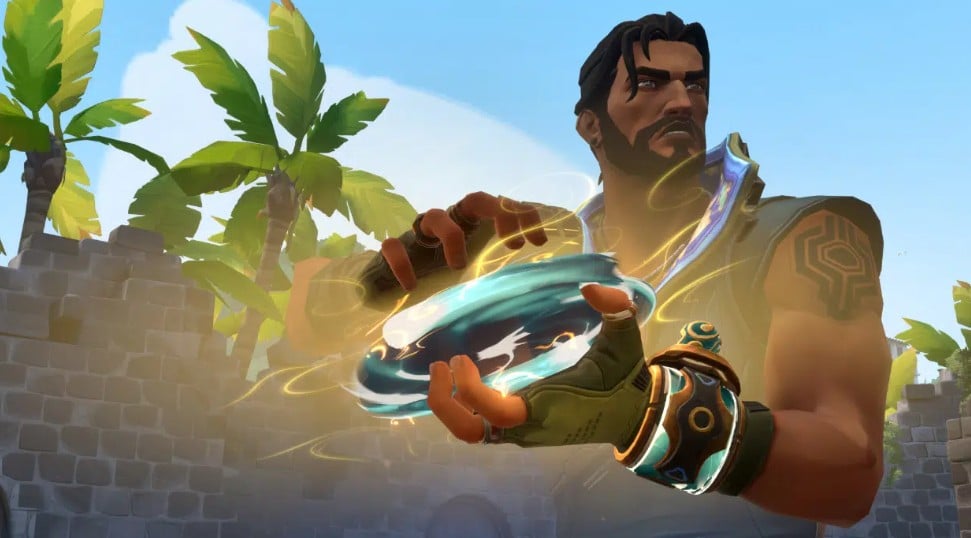
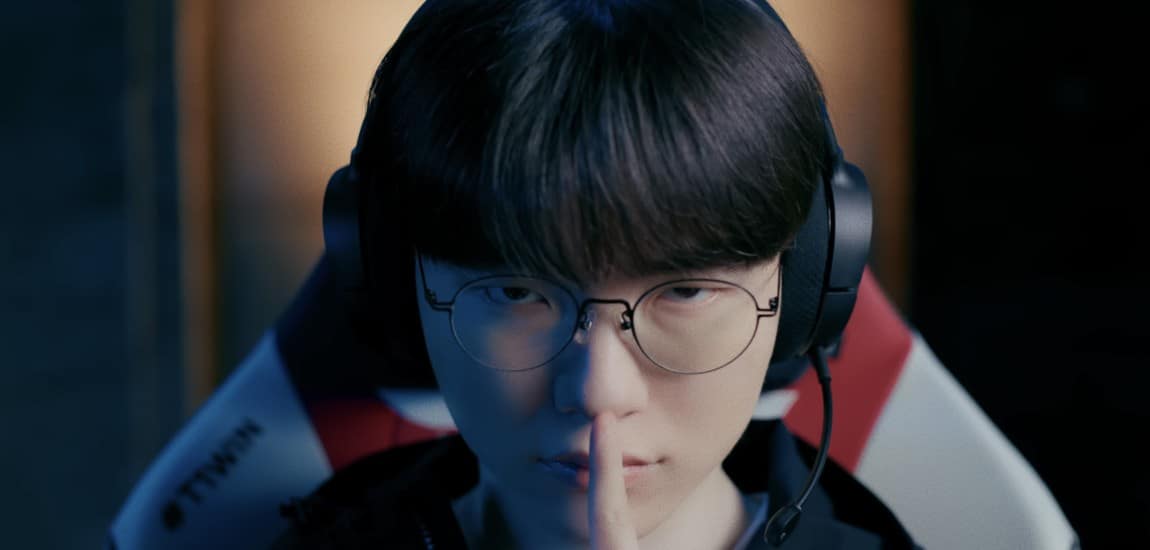
From breaking news and in-depth match analysis to exclusive interviews and behind-the-scenes content, we bring you the stories that shape the esports scene.
Monthly Visitors
User Satisfaction
Years experience
Latest Industry
